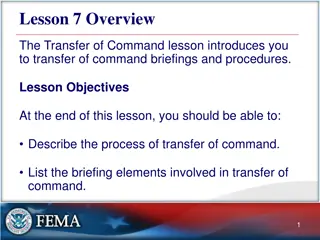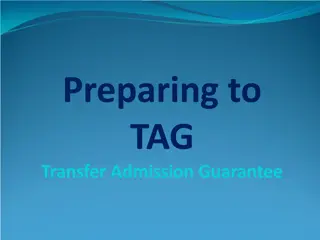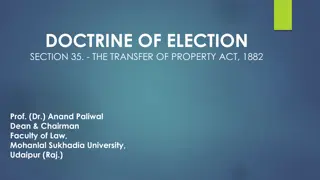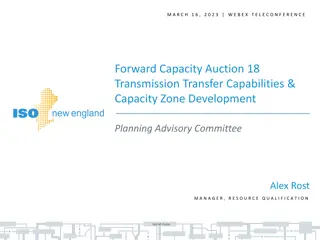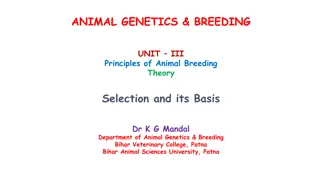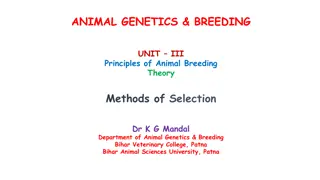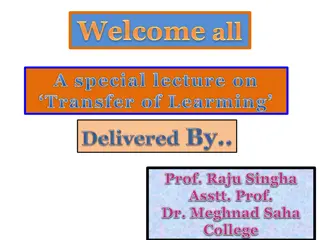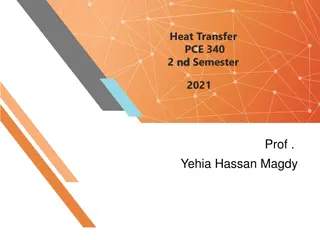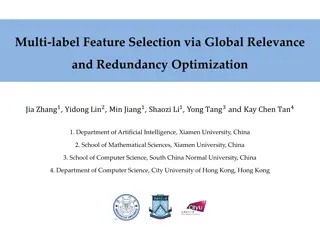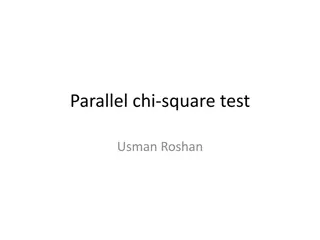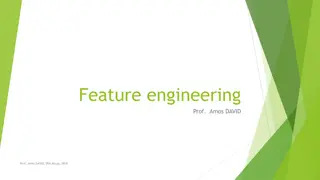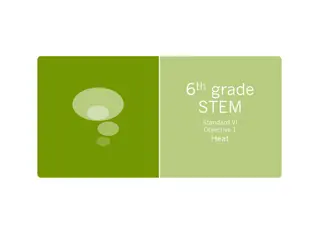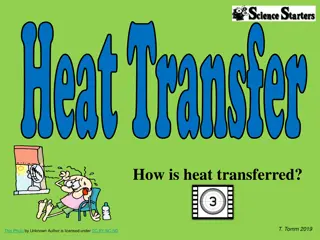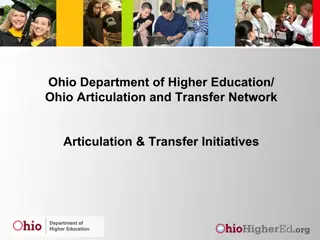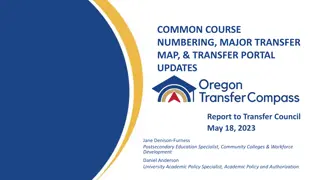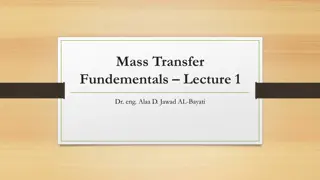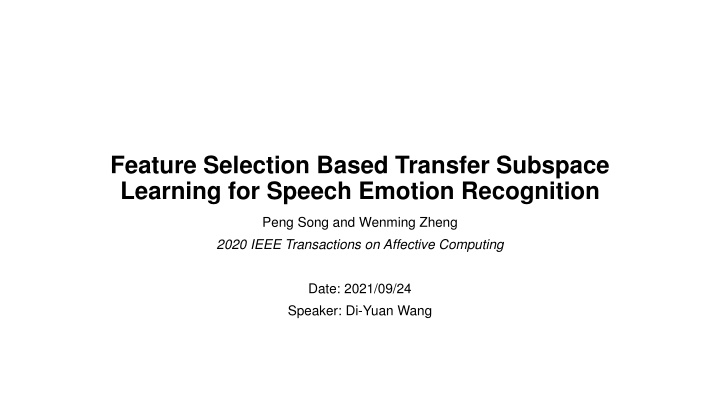
Feature Selection Based Transfer Subspace Learning for Speech Emotion Recognition
Discover the innovative approach of Feature Selection Based Transfer Subspace Learning (FSTSL) for enhancing cross-corpus speech emotion recognition. This method combines transfer subspace learning and feature selection to achieve more robust and discriminative common feature representations. Dive into the advancements in emotion classification through the integration of pattern recognition and machine learning techniques.
Download Presentation

Please find below an Image/Link to download the presentation.
The content on the website is provided AS IS for your information and personal use only. It may not be sold, licensed, or shared on other websites without obtaining consent from the author. If you encounter any issues during the download, it is possible that the publisher has removed the file from their server.
You are allowed to download the files provided on this website for personal or commercial use, subject to the condition that they are used lawfully. All files are the property of their respective owners.
The content on the website is provided AS IS for your information and personal use only. It may not be sold, licensed, or shared on other websites without obtaining consent from the author.
E N D
Presentation Transcript
Feature Selection Based Transfer Subspace Learning for Speech Emotion Recognition Peng Song and Wenming Zheng 2020 IEEE Transactions on Affective Computing Date: 2021/09/24 Speaker: Di-Yuan Wang
Outline Introduction FSTSL for Cross-Corpus Speech Emotion Recognition Experiments Conclusion Progress Report 2
Introduction With the advances in pattern recognition and machine learning techniques, a dozen of statistical algorithms have been developed for emotion classification in recent years. Gaussian mixture model (GMM), neural network (NN), support vector machine (SVM), Unfortunately, we notice that all these algorithms are conducted on the assumption that the training data and testing data are obtained from the same corpus. 3
Introduction Recently, transfer learning has been identified as an effective tool to address this problem by storing the knowledge obtained from the source data and applying this knowledge to the target data [11], [19], [20], [21]. All of these algorithms focus on finding the latent common feature representations to cope with the feature matching problem, and do not take into account the importance of feature selection together. [11] P. Song, et al., Cross-corpus speech emotion recognition based on transfer non negative matrix factorization, Speech Commun., vol. 83, pp. 34 41, 2016. [19] J. Deng, Z. Zhang, F. Eyben, and B. Schuller, Autoencoder-based unsupervised domain adaptation for speech emotion recognition, IEEE Signal Process. Lett., vol. 21, no. 9, pp. 1068 1072, Sep. 2014. [20] Y. Zong, W. Zheng, T. Zhang, and X. Huang, Cross-corpus speech emotion recognition based on domain-adaptive least- squares regression, IEEE Signal Process. Lett., vol. 23, no. 5, pp. 585 589, May 2016. [21] P. Song, Transfer linear subspace learning for cross-corpus speech emotion recognition, IEEE Trans. Affective Comput., 2017, doi: 10.1109/TAFFC.2017.2705696. 4
Introduction In this paper, we propose a novel cross-corpus speech emotion recognition method, called feature selection based transfer subspace learning (FSTSL). The central idea of our approach is that the transfer subspace learning and feature selection are conducted together. In this way, we can learn a projection matrix to map the features from different corpora into a common feature subspace. Therefore, the obtained common feature representations are more robust, and can have more discriminative power. 5
FSTSL for Cross-Corpus Speech Emotion Recognition Given a feature matrix ? = [??,??], where ??= [?1, ,???]?and ??= [???+1, ,??]?are the features of source and target corpus, respectively. Let ? = [??,??], where ??= [?1, ,???]?and ??= [???+1, ,??]?denote the low- dimensional feature representations of source and target corpora, respectively. In the general framework of subspace learning from the embedding viewpoint [28], [48], the optimal Ys is given by where I is the identity matrix, B is a diagonal matrix whose entries are column (or row, since U is a symmetric matrix) sums of weight matrix ? = [???]. ???indicates whether ??and ??are from the same class. [28] S. Yan, D. Xu, B. Zhang, H.-J. Zhang, Q. Yang, and S. Lin, Graph embedding and extensions: A general framework for dimensionality reduction, IEEE Trans. Pattern Anal. Mach. Intell., vol. 29, no. 1, pp. 40 51, Jan. 2007. [48] D. Cai, X. He, and J. Han, Spectral regression for efficient regularized subspace learning, in Proc. IEEE Int. Conf. Comput. Vis., 2007, pp. 1 8. 6
FSTSL for Cross-Corpus Speech Emotion Recognition Suppose we have c classes (emotion categories) and the kth class has ?? samples, ?1 + + ??= ??. Define According to [48], after some simple algebraic formulations, Thus, the low-dimensional representations are obtained as Y?= [?1, ,??] [48] D. Cai, X. He, and J. Han, Spectral regression for efficient regularized subspace learning, in Proc. IEEE Int. Conf. Comput. Vis., 2007, pp. 1 8. 7
FSTSL for Cross-Corpus Speech Emotion Recognition Next, we learn a projection matrix P to map the features from different corpora into a common subspace. The objective function can be given as We adopt the empirical maximum mean discrepancy (MMD) as the distance measurement, which compares the different distributions based on the distance between the sample means of two corpora, and the objective function is reformulated as 8
FSTSL for Cross-Corpus Speech Emotion Recognition At the same time, we perform feature selection via imposing ?2,1-norm on the projection matrix P, which has been shown very effective for sparse feature selection [43]. Therefore, we obtain the objective function as [43] F. Nie, H. Huang, X. Cai, and C. H. Ding, Efficient and robust feature selection via joint l2;1-norms minimization, in Proc. Int. Conf. Neural Inf. Process. Syst., 2010, pp. 1813 1821. 9
FSTSL for Cross-Corpus Speech Emotion Recognition In this section, we introduce a graph regularization term, which considers the geometric structure of data. Following the ideas of manifold learning [54], a natural assumption here is that if two data points ??and ??are close, then, ??and ??, the low- dimensional representations of these two data points, are also close to each other. For a data point ??, we can easily find its k neareast neighbors and put edges between these neighbors and ??. Let ? = [???] be the weight matrix, if ??is among the k nearest neighbors, ???= 1, otherwise, ???= 0. [54] M. Belkin, P. Niyogi, and V. Sindhwani, Manifold regularization: A geometric framework for learning from labeled and unlabeled examples, J. Mach. Learn. Res., vol. 7, no. 11, pp. 2399 2434, 2006. 10
FSTSL for Cross-Corpus Speech Emotion Recognition We can obtain our proposed feature selection based transfer subspace learning with graph regularization (FSTSL). The objective function can be written as 11
[59] F. Eyben, F. Weninger, F. Gross, and B. Schuller, Recent developments in openSMILE, the Munich open-source multimedia feature extractor, in Proc. 21st ACM Int. Conf. Multimedia, 2013, pp. 835 838. [60] F. Eyben and B. Schuller, openSMILE: The Munich open-source large-scale multimedia feature extractor, ACM SIGMultimedia Rec., vol. 6, no. 4, pp. 4 13, 2015. Experiments Datasets and Setting In our experiments, we used the openSMILE toolkit [59], [60] to extract these abovementioned acoustic features. Since we focus on learning the robust corpus-invariant feature representations, we adopted the popular linear SVM for emotion classification. 12
Experiments Compared with other Algorithms b: EMO-DB, e: eNTERFACE 13
Experiments Effectiveness Verification b: EMO-DB, e: eNTERFACE, f: FAU Aibo FSTSL1: ? and ? are set to zero, FSTSL2: ? = 0 14
Experiments Parameter Sensitivity ? = 0.1 ? = 1 ? = 100 15
Conclusion In this paper, we present a general framework, referred to as feature selection based transfer subspace learning, to address the cross-corpus speech emotion recognition problem. Furthermore, many existing unsupervised and semi-supervised algorithms can be easily incorporated into the FSTSL framework. Extensive experiments show that FSTSL is effective and robust for cross- corpus speech emotion recognition tasks and can significantly outperform state-of-the-art transfer learning methods. 16
Dataset 58 videos from Conversational Question Answering MMSE 0-30 Training Testing = 9 1 18
Label Distribution MMSE Score = 16 Gaussian Distribution mean = 16 std = 1 19
Model Face image x10 CNN (VGG16) Late Fusion MMSE Speech signal x10 352-D FCN Speech features Extract 176-d features every 0.5 seconds using openSMILE Calculate mean and standard deviation of 176-d features Obtain 352-d 176+176 features for a clip 20
Result Visual : Audio RMSE Spearman Corr. Pearson Corr. 10:0 6.167344 0.21606 0.215529 9:1 6.112918 0.353468 0.266559 8:2 6.150949 0.345085 0.252202 7:3 5.573271 0.439132 0.399735 6:4 5.34467 0.543667 0.406921 5:5 5.158617 0.539115 0.477511 4:6 4.969626 0.606559 0.559351 3:7 5.008402 0.655996 0.626604 2:8 5.146405 0.559687 0.520463 1:9 5.100084 0.562748 0.534656 0:10 5.100084 0.562748 0.534656 21
THANKS 22





